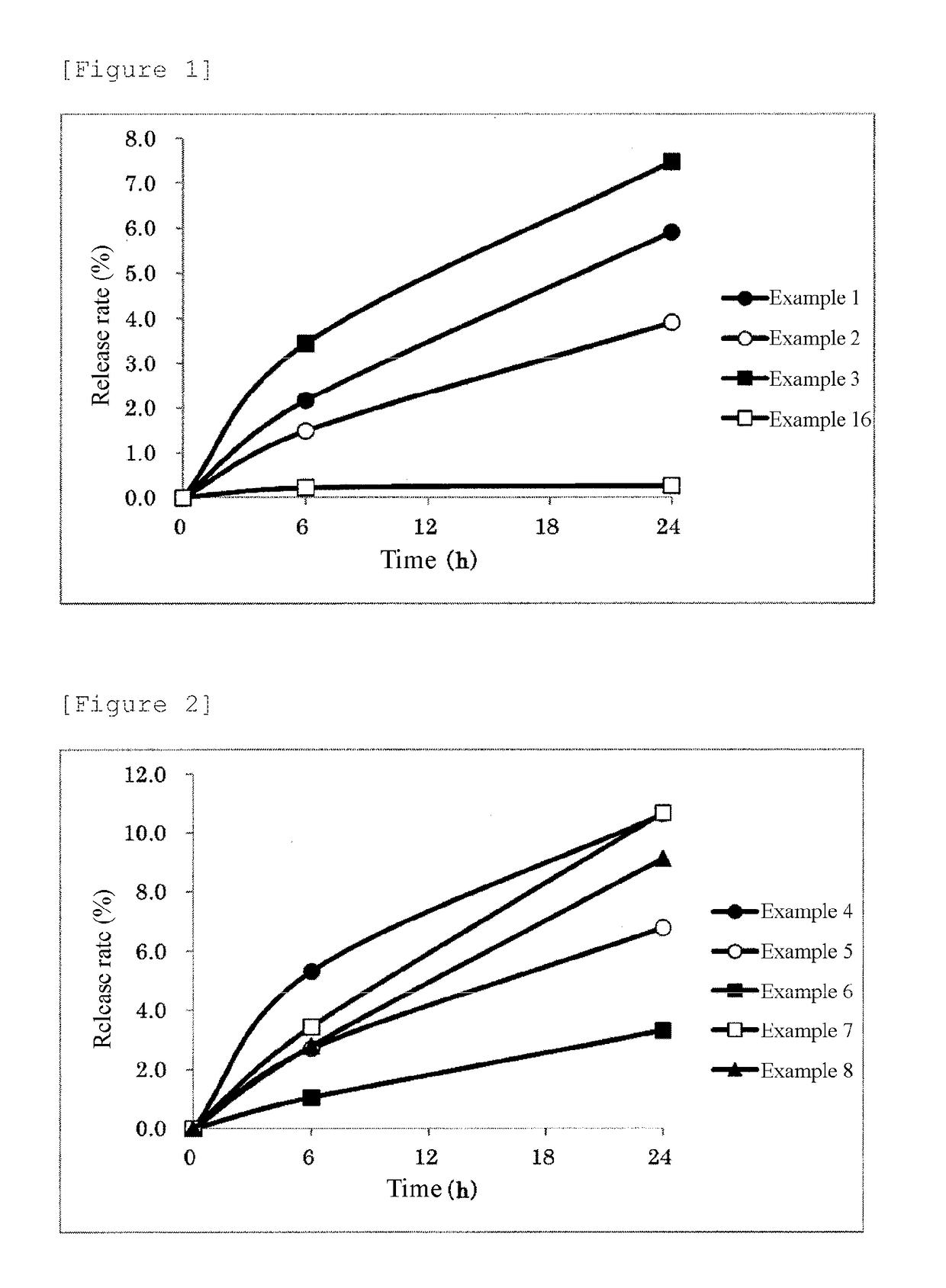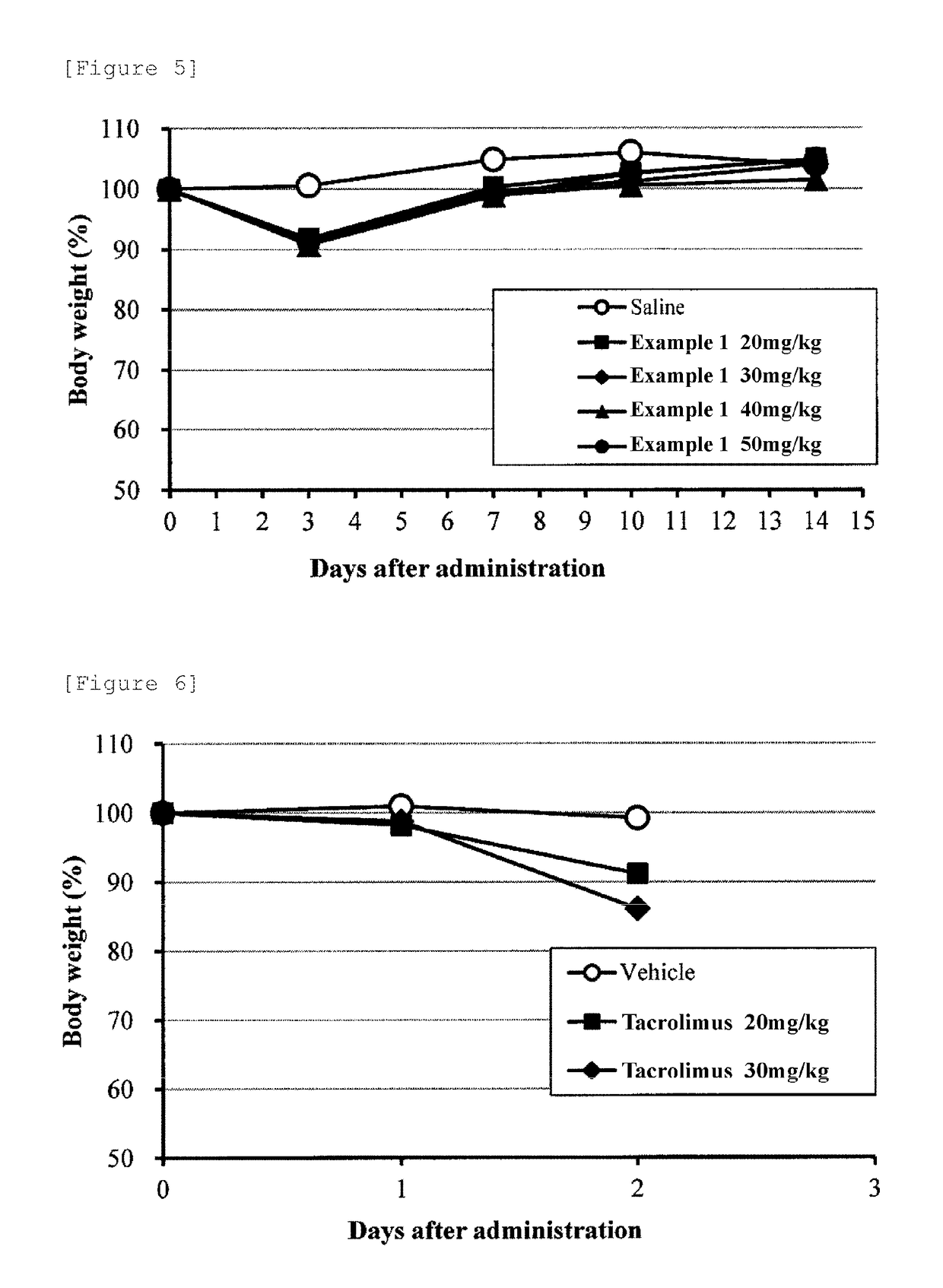Polymeric Derivative Of Macrolide Immunosuppressant
- Summary
- Abstract
- Description
- Claims
- Application Information
AI Technical Summary
Benefits of technology
Problems solved by technology
Method used
Image
Examples
synthesis example 1
[0139]Synthesis of Polyethylene Glycol-α-Polyaspartic Acid Block Copolymer (Polyethylene Glycol Molecular Weight: 12,000, Degree of Polymerization of Polyaspartic Acid: 20.9) (Compound 1)
[0140]A polyethylene glycol having a methoxy group at one end and a 3-aminopropyl group at another end (SUNBRIGHT MEPA-12T, manufactured by NOF Corp., average molecular weight 12 kilodaltons, 100.0 g) was dissolved in DMSO (1,900 mL), subsequently γ-benzyl-L-aspartic acid-N-carboxylic acid anhydride (BLA-NCA, 55.3 g, 27 equivalents) was added to the solution, and the mixture was stirred overnight at 32.5° C. The reaction liquid was added dropwise to a mixed solvent of ethanol (4,000 mL) and diisopropyl ether (16,000 mL) for one hour, and the mixture was stirred for one hour at room temperature. A precipitate was collected by filtration and then dried in a vacuum, and a solid (142.7 g) was obtained. The solid (140.0 g) thus obtained was dissolved in DMF (1,400 mL), acetic anhydride (4.4 mL) was added...
synthesis example 2
[0141]Synthesis of Polyethylene Glycol-α-Polyaspartic Acid Block Copolymer (Polyethylene Glycol Molecular Weight: 12,000, Degree of Polymerization of Polyaspartic Acid: 40) (Compound 2)
[0142]The indicated Compound 2 was obtained by using 51.25 equivalents of γ-benzyl-L-aspartic acid-N-carboxylic acid anhydride for a polyethylene glycol having a methoxy group at one end and a 3-aminopropyl group at another end according to the method described in Synthesis Example 1. The degree of polymerization of aspartic acid in one molecule of the present compound based on the titration value obtained using a 0.1 N potassium hydroxide solution was about 40.8.
synthesis example 3
[0143]Synthesis of Aspartic Acid-1-Glycinyl Methyl Ester-4-Benzyl Ester Hydrochloride (Compound 3)
[0144]N-(t-butoxycarbonyl)aspartic acid-4-benzyl ester (12.01 g) and L-glycine methyl ester hydrochloride (4.65 g) were dissolved in DMF (180 mL), and then 1-ethyl-3-[3-(dimethylamino)propyl]carbodiimide hydrochloride (EDCI) (10.66 g), l-hydroxybenzotriazole monohydrate (HOBt.H2O) (6.82 g), and diisopropylethylamine (6.3 mL) were added to the solution. The mixture was stirred for 2.5 hours. Water was added to the reaction liquid, and the mixture was extracted with ethyl acetate. The organic layer was washed with a 5% aqueous solution of citric acid, a saturated aqueous solution of sodium hydrogen carbonate, and saturated brine. The organic layer was dried over sodium sulfate, subsequently ethyl acetate was removed by concentration under reduced pressure, and purification by silica gel column chromatography was performed. The purified product was dried in a vacuum, and thus a white powde...
PUM
| Property | Measurement | Unit |
|---|---|---|
| Time | aaaaa | aaaaa |
| Time | aaaaa | aaaaa |
| Time | aaaaa | aaaaa |
Abstract
Description
Claims
Application Information
 Login to View More
Login to View More - R&D
- Intellectual Property
- Life Sciences
- Materials
- Tech Scout
- Unparalleled Data Quality
- Higher Quality Content
- 60% Fewer Hallucinations
Browse by: Latest US Patents, China's latest patents, Technical Efficacy Thesaurus, Application Domain, Technology Topic, Popular Technical Reports.
© 2025 PatSnap. All rights reserved.Legal|Privacy policy|Modern Slavery Act Transparency Statement|Sitemap|About US| Contact US: help@patsnap.com



